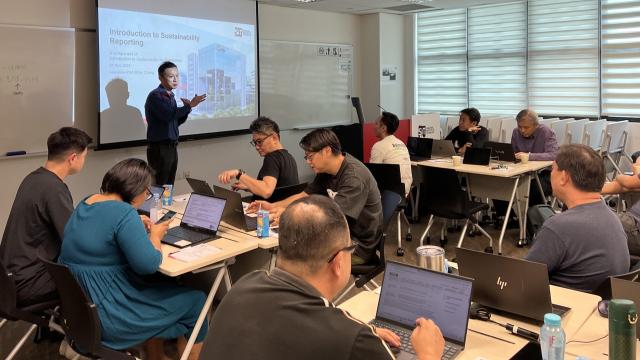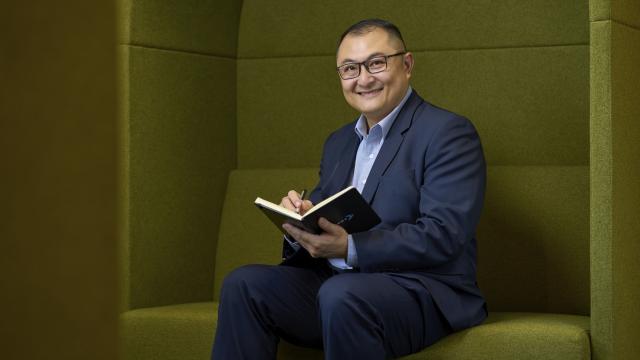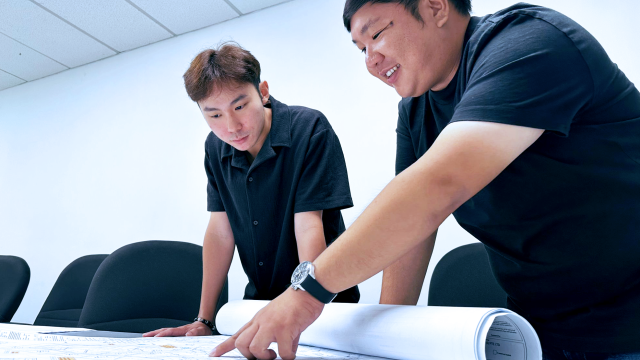The university’s Virtual Reality (VR) Mobility Training project aims to explore the ways in which VR can help patients with mobility constraints relive meaningful daily experiences. Find out how this multi-disciplinary project was conceptualised and brought to life, together with physiotherapists from Ng Teng Fong General Hospital.
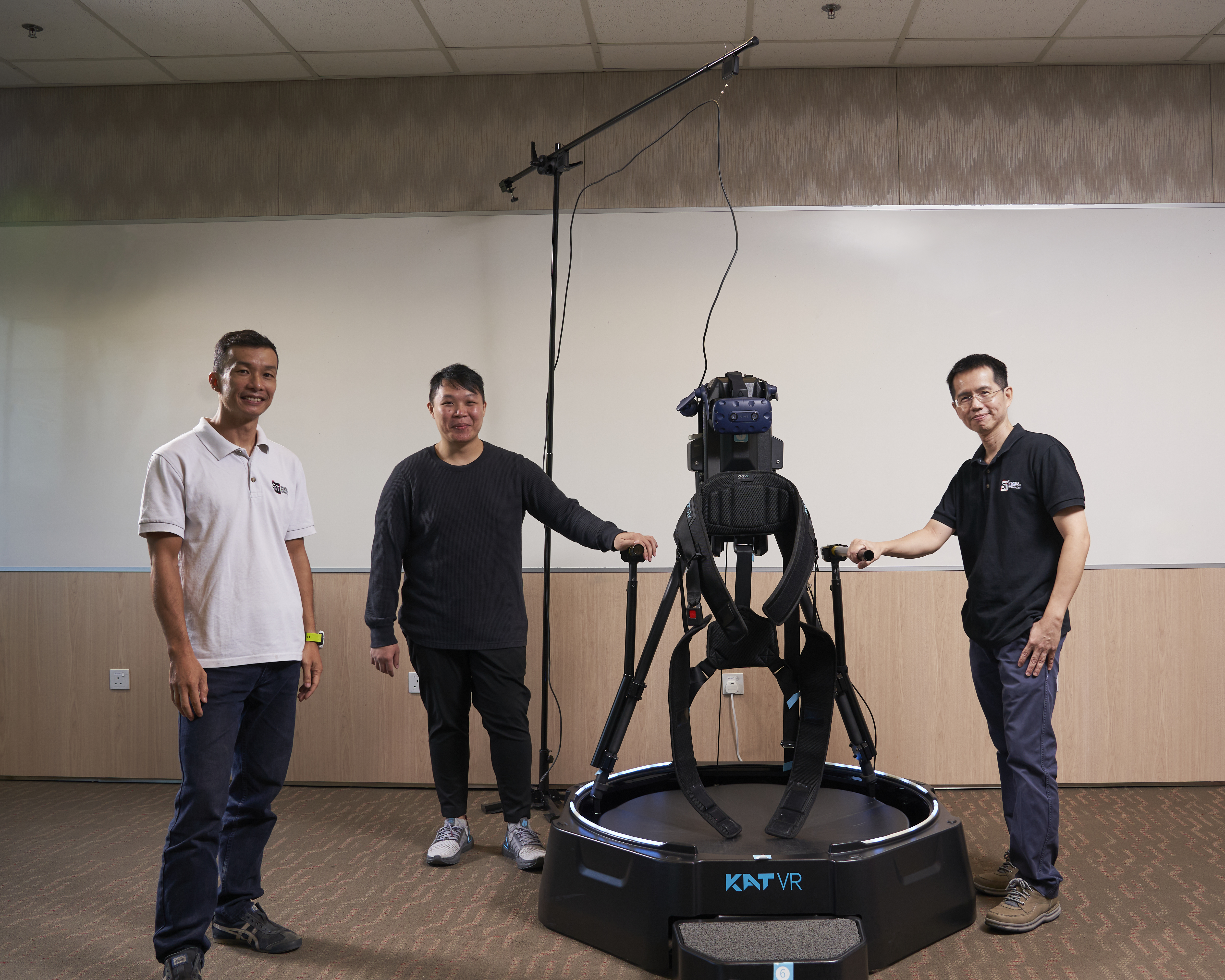
The SIT team spearheading the development of the Virtual Reality Mobility Training include (from left) A/Prof Benjamin Soon, Health and Social Sciences; alumnus Lim Zhiliang, Mechanical Engineering; and A/Prof Alfred Tan, Engineering. (SIT Photo: Keng Photography/Tan Eng Keng)
It seems like an ordinary day for an SIT student. As he strolls up and down the aisle of a supermarket, a hologram of an arrow points in the direction he should walk.
Wearing Virtual Reality (VR) goggles and strapped at the waist to a modified treadmill, the student is actually on campus, walking on a moving platform and exploring a virtual environment.
He is testing a prototype of the university’s Virtual Reality Mobility Training (VRMT) project. The system aims to explore the ways VR can help patients with mobility constraints relive meaningful daily experiences, such as grocery shopping in a supermarket, in a safe and pleasant virtual space.
This forward-thinking project came about through a simple idea by Associate Professor Benjamin Soon from SIT’s Health and Social Sciences Cluster. He aims to combine VR technology and an omni-directional platform in order to improve rehabilitation efforts for patients with mobility contraints.
A/Prof Soon got his inspiration from the development of VR in gaming. But the VRMT system is more advanced, he explained. The omni-directional VR treadmill, also known as the Kat Walk system, provides a platform for the user to walk on the spot whilst waist-strapped for safety. In addition, users can rely on handlebars for support instead of roaming freely around in a room.
It is also different from traditional rehabilitation methods where patients are expected to walk or run on a conventional treadmill. The VRMT’s treadmill platform allows the user to decide whether to walk, run, sit, or even squat.
The VR element allows users to immerse themselves in a virtual environment familiar to them. The system comes with 360˚ pre-recorded videos of real-life surroundings that simulate a realistic environment. As a result, when a user looks through the VR goggles, they will be able to see scenes of a recorded environment that move according to their walking pace.
“The system will help train the muscles used in walking and standing balance. The VR element may even get uers to go out and motivate them to use the system rather than lie in bed,” added A/Prof Soon.
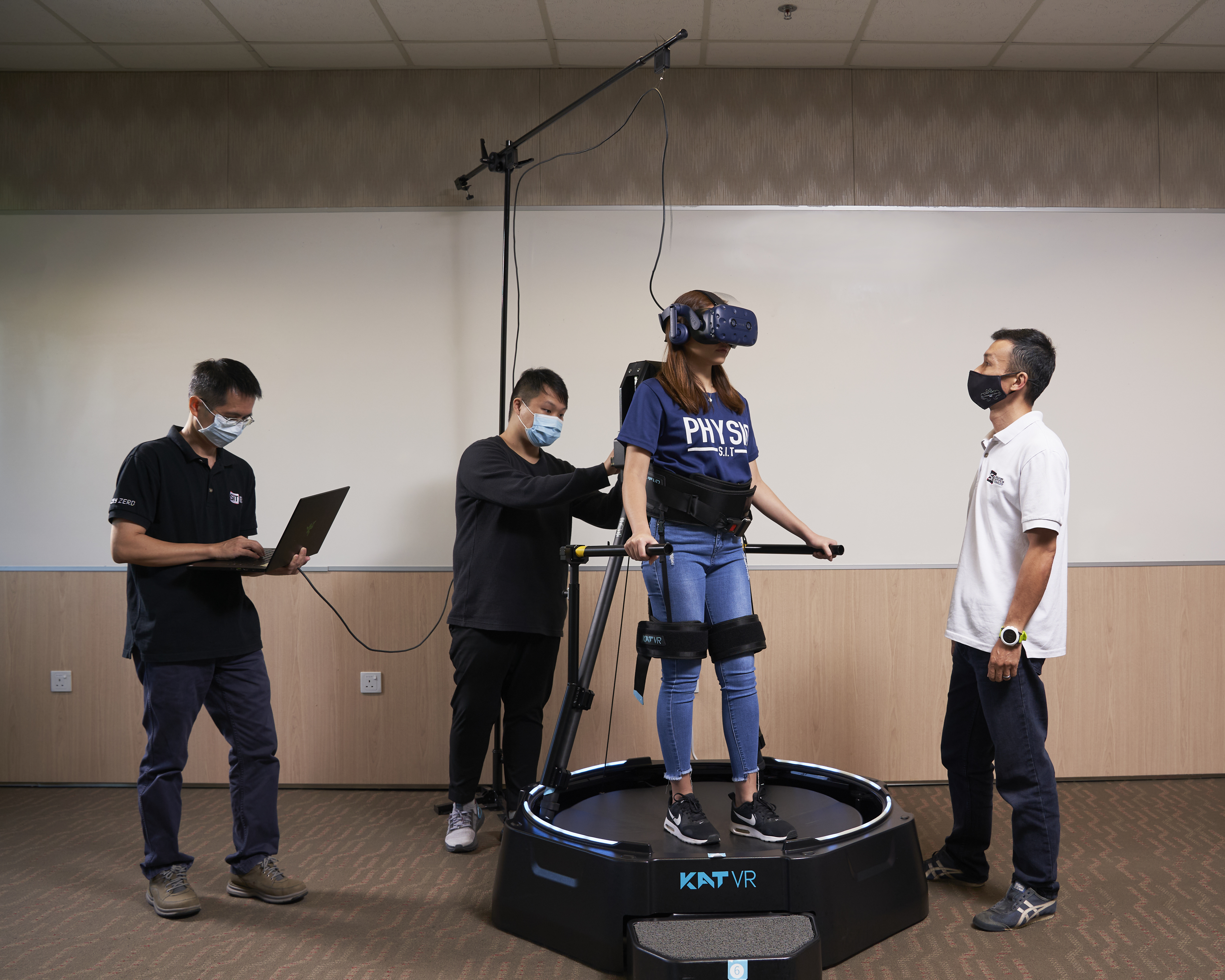
The team demonstrating how the VRMT works at SIT’s Centre for Immersification. (SIT Photo: Keng Photography/Tan Eng Keng)
Cross-cluster Collaboration
The VRMT project is a collaboration between faculty and students from SIT’s Physiotherapy and Mechanical Engineering programmes; the Infocomm Technology cluster; the university’s Professional Officers; and physiotherapists from Ng Teng Fong General Hospital (NTFGH).
Lim Zhiliang, an alumnus from the Mechanical Engineering programme, worked on the VRMT for his final-year project in 2020. As the first student to start work on the VRMT, he had to study available VR platforms in the market and come up with a product that would work well for the target users – patients with mobility issues.
This meant drilling down to the details such as the specific material to use for the prototype to ensure it was lightweight enough for the user, while providing sufficient safety support. The safety support is essential because the omni-directional platform is designed for VR gaming use, but in the case of the project, it is meant for patients.
“We used aluminium for the prototype, which is light yet strong enough to withstand any load,” said Zhiliang, who also worked with a fabricator to construct the prototype.
Once the prototype was completed, the next step was to test it out.
Fellow alumnus Nicodemus Tan from the Physiotherapy programme also worked on the VRMT for his final-year project. “The objective of our study was to understand the feasibility of incorporating a VR machine to physiotherapy treatments, and as an adjunct to conventional physiotherapy,” he said.
To do so, he helped test the VRMT system on patients. He strapped the device onto users, set up the VR goggles, ran the VR programme, and recorded any symptoms experienced by users. He found that the device’s detection system was overly sensitive, which resulted in a poor experience for users. The resolution of the VR visuals was not clear, another area he flagged for future improvements.
Work in Progress
To date, the VRMT prototype has been tested on a total of 35 individuals, of whom eight are professional physiotherapists. These trial sessions are useful in helping the VRMT team identify the areas that need improvement.
For example, users may experience nausea and cybersickness should the VRMT device fail to accurately capture their movements. If the user’s walking speed and the video playback speed do not match, users may feel dizzy and lightheaded.
Another issue is that users would not able to operate the VR device by themselves. Since they are blinded from the “real” world by the VR goggles, users would need someone to help them switch the device on or off once they are on the system.
Despite these glitches, the VRMT team is still optimistic about the system’s potential use in rehabilitating patients with mobility conditions.
“What we found is that VR technology and treadmill, when used separately, show promising therapeutic potential for patients with stroke, Parkinson’s disease, or even impairments such as pain or imbalance,” said Jilene Lau, a physiotherapy graduate who also worked on the project.
Dr Cai Cong Cong, Senior Principal Physiotherapist from the Rehabilitation Department of NTFGH, added that the device represents a new treatment approach that could potentially improve rehabilitation efficiencies and patient uptake.
“The gamification features may pique patients’ curiosity and interest them to try the device,” he said.

